|
|
|
Sort Order |
|
|
|
Items / Page
|
|
|
|
|
|
|
| Srl | Item |
| 1 |
ID:
146011
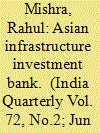

|
|
|
|
|
| Summary/Abstract |
Lauded as one of the most remarkable Chinese initiatives in the international financial arena, the Asian Infrastructure Investment Bank (AIIB) sets the stage for China’s greater role in the international economic system as a prominent stakeholder. Headquartered in Beijing, the bank is expected to play a key role in plugging the infrastructure gaps in Asia, which have been estimated at US$8 trillion between the years 2010 and 2020. The setting up of the AIIB will have far-reaching economic as well as politico-strategic implications for countries across Asia and beyond. While the AIIB has been seen as a remedy to address infrastructure deficit in Asia, it is unlikely to meet the US$8 trillion goal on its own. The biggest challenge before the bank, therefore, is to prioritise in terms of selecting projects so that it optimally utilises the available financial resources and functions as a transparent and impartial organisation, in addition to making a swift and smooth transition from a ‘Chinese initiative’ to a ‘China-led initiative’ that yields equitable benefits to all its member countries.
|
|
|
|
|
|
|
|
|
|
|
|
|
|
|
|
| 2 |
ID:
145629
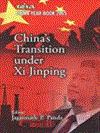

|
|
|
|
|
| Publication |
New Delhi, Pentagon Press, 2016.
|
| Description |
xviii, 427p.hbk
|
| Standard Number |
9788182749078
|
|
|
|
|
|
|
|
|
|
|
|
Copies: C:2/I:0,R:0,Q:0
Circulation
| Accession# | Call# | Current Location | Status | Policy | Location |
| 058700 | 327.51/PAN 058700 | Main | On Shelf | General | |
| 058701 | 327.51/PAN 058701 | Main | On Shelf | General | |
|
|
|
|
| 3 |
ID:
165152
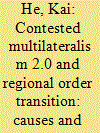

|
|
|
|
|
| Summary/Abstract |
This article proposes a new concept of ‘contested multilateralism 2.0’ to describe the puzzling institutional building efforts by non-ASEAN members after the 2008 global financial crisis (GFC) in the Asia-Pacific. It suggests that different to ‘multilateralism 1.0’ of the 1990s, which was mainly led by ASEAN, this wave of multilateralism has been initiated by other powers, such as the United States, China, Japan, Australia and South Korea, either by forming new institutions or by reinvigorating existing ones. This article advances an institutional balancing argument. It suggests that ‘contested multilateralism 2.0’ is a result of institutional balancing among major states under the conditions of high strategic uncertainty and high economic interdependence after the GFC. One unintended consequence may be that it could well lead to a more peaceful transformation of the regional order in the Asia-Pacific if regional security hotspots, such as the Korean crisis and the South China Sea dispute, can be managed appropriately.
|
|
|
|
|
|
|
|
|
|
|
|
|
|
|
|
| 4 |
ID:
163466


|
|
|
|
|
| Summary/Abstract |
This article analyzes elite opinion in South Korea as it applies to China's One Belt, One Road initiative (OBOR), in order to better understand how a prominent Asia-Pacific middle power and US ally is approaching this development. Through a close analysis of the writing of foreign-policy elites in South Korea from 2013 to 2017, the study finds that OBOR was generally depicted as significant to China's re-emergence in regional and global affairs, but not as wholly detrimental to South Korean interests. Elites did not speak with one voice, but presented the government with a comparatively sanguine view of OBOR. The debate, we illustrate, created unlikely alliances between left- and right-leaning elites about some aspects of the initiative, but it also revealed tensions among conservative and centrist elites. In seeking to demonstrate their relevance to policy makers, however, elites inadvertently underlined their growing distance from the general public.
|
|
|
|
|
|
|
|
|
|
|
|
|
|
|
|
| 5 |
ID:
168106
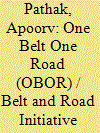

|
|
|
|
|
| Summary/Abstract |
The economic prowess which China gained in last three decades has given its leadership the confidence to bring the blueprint of ‘Chinese Dream’, in the form of ‘Belt and Road Initiative (BRI)’, on the world stage. BRI is a major economic project for infrastructure development around the world which comprises ‘Silk Road Economic Belt’ and ‘Maritime Silk Road’.
|
|
|
|
|
|
|
|
|
|
|
|
|
|
|
|
| 6 |
ID:
167134
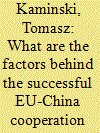

|
|
|
|
|
| Summary/Abstract |
Analysing the relations between the EU and China one can notice a growing network of links on all levels, including subnational. Within the framework of the One Belt One Road (OBOR) Initiative Chinese regions are eager to develop contacts with European counterparts. The case of the Lodzkie region’s (Poland) cooperation with Sichuan Province is often presented in media as a flagship example of taking the advantage of the possibilities posed by the OBOR. The direct cargo train connection with China has been accompanied by close political relations on the regional level as well as academic cooperation. Neither distance nor great asymmetries between the partners impede smooth collaboration in the Lodzkie case. The main aim of this paper is to answer the question what are the factors behind the success of the Lodzkie region in order to recognise the conditions that may play an important role in the process of building strong bilateral links between European and Chinese subnational units. The Lodzkie case clearly shows the key role of the personal factor. Politicians and officials have identified a great potential in a small-scale business initiative and have helped it to enhance in cooperation with local stakeholders (the city authorities, academia, local companies). Moreover, they have been able to create an attractive story which appeals to international media and attracts business.
|
|
|
|
|
|
|
|
|
|
|
|
|
|
|
|
| 7 |
ID:
164081
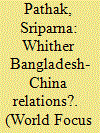

|
|
|
|
|
| Summary/Abstract |
With or without China’s grand One Belt One Road (OBOR) initiative, Chinese footsteps in South Asia have been ever increasing-be it in the military context or economic. This has been interpreted as a source of immense concern in India. China’s all weather friendship with Pakistan, tacit support to Pakistan’s proxy wars against India and the construction of the China-Pakistan economic corridor through Pakistan Occupied Kashmir- an integral part of India are just some of the concerns India has with China’s presence in South Asia.
|
|
|
|
|
|
|
|
|
|
|
|
|
|
|
|
|
|
|
|
|